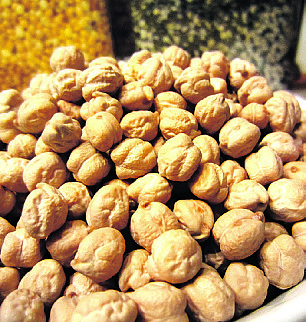Chickpeas, also called garbanzo/dengubeans or gram, are regarded as beans, yet botanically; they are neither beans nor peas.
The chickpea is an annual legume, a bushy plant that grows to about 18 inches tall and has dark green, compound leaflets.
In Uganda, there are mainly two varieties of chickpea; Desi and Kabuli. Desi has pink flowers, red to purplish pigmentation on stems, dark-coloured and a thick seed coat.
Kabuli, on the other hand, has white flowers, white or beige-coloured seeds shaped like a ram’s head and a smooth seed surface.

Mature grains contain between 12-31% proteins, 60-655 carbohydrates, 3-12% ash and 6% fat. It can be eaten as boiled or roasted grains, beverage and as flour.
Suitable soils
Chickpeas can be grown in coarse-textured sandy and fine-textured deep black soils.
However, the best soils are deep loams or silty clay loams with a pH of 6.0-8.0 (pH is the amount of nitrogen in the soil).
Salty soils or fields with a high water table are not suitable for growing chickpeas. In Uganda chickpea is performing well mostly in the west and the east.
Chickpea is a post-rainy season crop, usually planted at the end of peak rains.
Pre-sowing irrigation may be necessary, if the soil moisture is not adequate for germination. However, Kabuli chickpea should never be irrigated immediately after sowing because its seeds can deteriorate quickly.
Planting and spacing
Seeds should be sown 1.5 to two inches deep, spaced three to six inches apart. Thin successful plants to six inches apart; cut away thinned plants at soil level with scissors so as not to disturb the roots.
Space rows 18 to 24 inches apart. Do not soak seed before sowing. Avoid heavy watering after sowing as this can cause the seeds to crack.
Water and feeding
Keep planting beds well-moistened until the chickpeas have germinated. Water the chickpeas regularly during flowering and pod formation.
Avoid overhead watering, which can cause flowers and pods to fall off. Mulch the gardens when the weather becomes warm to conserve soil moisture. Add aged compost to seed beds before planting the chickpeas.
You also need to side-dress chickpeas with aged compost at mid-season. Avoid adding nitrogen-rich fertilisers to seed beds. Like other legumes, chickpeas have nitrogen fixing bacteria in their root nodules so need no extra nitrogen fertilisers.
Avoid handling chickpeas when they are wet or covered with dew to prevent the spread of fungus spores.
Keep planting beds weed-free, but cultivate around chickpeas carefully in order not to disturb the plant’s shallow roots. Rotate chickpeas and other legumes to add nitrogen to the soil.
Pests
Chickpeas can be attacked by aphids, leafhoppers, mites as well as bean and flea beetles. Aphids, leafhoppers and mites can be sprayed with a flush of water from the hose or controlled with insecticide soap.
Look out for eggs and crush them between your fingers and thumb. Aphids can spread bean mosaic virus. To prevent pests, keep the garden free of debris.
Diseases
The major diseases that attack chickpeas include fusarium wilt, collar rot and dry rot. Chickpeas are also susceptible to blight, mosaic and anthracnose. This is why you need to plant disease-resistant varieties.
Keep the garden free of debris. Avoid handling plants when they are wet to prevent the spread of fungal spores.
Chickpeas are susceptible to many soilborne diseases. Rotating beans so that they do not grow in the same field for more than three years will reduce soil-borne diseases.
To fight diseases and pests, plant at the right time, apply fungicides, especially for blight and grey mould and use insecticide for pod borers and other pests.
Harvesting
Chickpeas will be ready for harvest about 100 days after planting.
Fresh chickpeas can be picked for eating when pods are still immature and green and can be eaten like snap beans.
For dried chickpeas, harvest the entire plant when the leaves have withered and turned brown; place the plant on a flat, warm surface and allow the pods to dry.
Collect the seed as the pods split. Seeds that will barely dent when bitten are sufficiently dry. Modern technology has gone up now you can get flour, cakes, biscuits and many more from chickpea.
Storing and preservation
You can apply a little vegetable oil on the seeds to keep away pests. Store the chickpeas in air tight containers.
Unshelled chickpeas will keep in the refrigerator for up to one week. Dried, shelled chickpeas will keep in a cool, dry place for up to a year. Chickpeas can be frozen, canned or sprouted.





